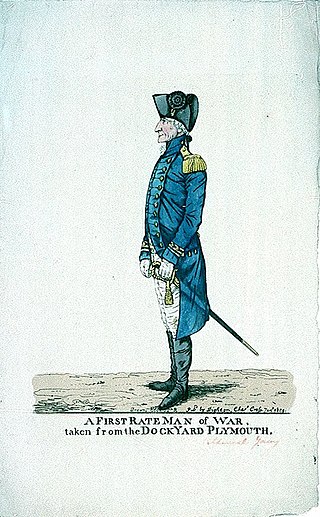Related Research Articles

The Keeper or Master of the Rolls and Records of the Chancery of England, known as the Master of the Rolls, is the President of the Civil Division of the Court of Appeal of England and Wales and Head of Civil Justice. As a judge, the Master of the Rolls is second in seniority in England and Wales only to the Lord Chief Justice. The position dates from at least 1286, although it is believed that the office probably existed earlier than that.

The Commander-in-Chief of the Forces, later Commander-in-Chief, British Army, or just the Commander-in-Chief (C-in-C), was (intermittently) the professional head of the English Army from 1660 to 1707 and of the British Army from 1707 until 1904. In 1904 the office was replaced with the creation of the Army Council and the appointment of Chief of the General Staff.

Rear Admiral Sir Thomas Troubridge, 1st Baronet was a Royal Navy officer. As a junior officer he saw action at the Battle of Sadras in February 1782 during the American Revolutionary War and the Battle of Trincomalee in September 1782 during the Anglo-French War. He commanded the third-rate Culloden at the Battle of Cape St Vincent in February 1797 during the French Revolutionary Wars. He went on to be First Naval Lord and then served as Commander-in-Chief, East Indies, during the Napoleonic Wars.

The Vice-Chamberlain of the Household is a member of the Royal Household of the Sovereign of the United Kingdom. The officeholder is usually a senior government whip in the British House of Commons ranking third or fourth after the Chief Whip and the Deputy Chief Whip. The Vice-Chamberlain is the Deputy to the Lord Chamberlain of the Household and, like the Lord Chamberlain, carries a white staff of office when on duty on state occasions.

The Lieutenant of the Tower of London serves directly under the Constable of the Tower. The office has been appointed at least since the 13th century. There were formerly many privileges, immunities and perquisites attached to the office. Like the Constable, the Lieutenant was usually appointed by letters patent, either for life or during the King's pleasure.

Justice of the Common Pleas was a puisne judicial position within the Court of Common Pleas of England and Wales, under the Chief Justice. The Common Pleas was the primary court of common law within England and Wales, dealing with "common" pleas. It was created out of the common law jurisdiction of the Exchequer of Pleas, with splits forming during the 1190s and the division becoming formal by the beginning of the 13th century. The court became a key part of the Westminster courts, along with the Exchequer of Pleas and the Court of King's Bench, but with the Writ of Quominus and the Statute of Westminster, both tried to extend their jurisdiction into the realm of common pleas. As a result, the courts jockeyed for power. In 1828 Henry Brougham, a Member of Parliament, complained in Parliament that as long as there were three courts unevenness was inevitable, saying that "It is not in the power of the courts, even if all were monopolies and other restrictions done away, to distribute business equally, as long as suitors are left free to choose their own tribunal", and that there would always be a favourite court, which would therefore attract the best lawyers and judges and entrench its position. The outcome was the Supreme Court of Judicature Act 1873, under which all the central courts were made part of a single Supreme Court of Judicature. Eventually the government created a High Court of Justice under Lord Coleridge by an Order in Council of 16 December 1880. At this point, the Common Pleas formally ceased to exist.

Sir William Young GCB was an officer of the Royal Navy who saw service during the American War of Independence, and the French Revolutionary and Napoleonic Wars. He should not be confused with his namesake and near contemporary Admiral William Young.
James Young was an officer of the Royal Navy who saw service during the French Revolutionary and Napoleonic Wars, rising to the rank of vice-admiral of the white.

Edward Knowles was an officer of the Royal Navy, who saw service during the Seven Years' War.
Eastman's Royal Naval Academy, originally in Southsea and later at Winchester, both in England, was a preparatory school. Between 1855 and 1923 it was known primarily as a school that prepared boys for entry to the Royal Navy. Thereafter, it was renamed Eastman's Preparatory School and continued until the 1940s. According to Jonathan Betts, it was "considered one of the top schools for boys intended for the Navy".

James Stanier Clarke (1766–1834) was an English cleric, naval author and man of letters. He became librarian in 1799 to George, Prince of Wales.
The Monthly Mirror was an English literary periodical, published from 1795 to 1811, founded by Thomas Bellamy, and later jointly owned by Thomas Hill and John Litchfield. It was published by Vernor & Hood from the second half of 1798.

James Burnes was a Scottish doctor and surgeon in India, who became physician-general of Bombay.
References
- ↑ Stephen, Leslie, ed. (1887). . Dictionary of National Biography . Vol. 10. London: Smith, Elder & Co.
- ↑ Freemasons' Magazine (1871). "The Freemasons' Quarterly (Magazine and) Review [afterw.] The Freemasons' Monthly Magazine. [Continued as] The Freemasons' Magazine and Masonic Mirror". The Freemasons' Magazine and Masonic Mirror. Bro. Henry George Warren, 2, Red Lion Court, Fleet Street. p. 249 . Retrieved 4 September 2013.
- ↑ McConnell, Anita. "Gibson, Francis". Oxford Dictionary of National Biography (online ed.). Oxford University Press. doi:10.1093/ref:odnb/10617.(Subscription or UK public library membership required.)
- ↑ Hall, Christopher D. "Penrose, Charles Vinicombe". Oxford Dictionary of National Biography (online ed.). Oxford University Press. doi:10.1093/ref:odnb/21888.(Subscription or UK public library membership required.)
- ↑ Cordingly, David. "Pocock, Nicholas". Oxford Dictionary of National Biography (online ed.). Oxford University Press. doi:10.1093/ref:odnb/22425.(Subscription or UK public library membership required.)